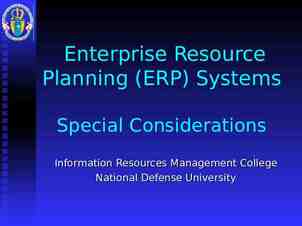Natural Language Processing Neelnavo Kar Alex Huntress-Reeve
20 Slides330.50 KB
Natural Language Processing Neelnavo Kar Alex Huntress-Reeve Robert Huang Dennis Li
What is Natural Language Processing? NLP is an interdisciplinary field that uses computational methods to: o Investigate the properties of written human language and model the cognitive mechanisms underlying the understanding and production of written language. o Develop novel practical applications involving the intelligent processing of written human language by computer.
What is NLP? (cont.) NLP plays a big part in Machine learning techniques: o automating the construction and adaptation of machine dictionaries o modeling human agents' desires and beliefs essential component of NLP closer to AI We will focus on two main types of NLP: o Human-Computer Dialogue Systems o Machine Translation
Human-Computer Dialogue Systems Usually with the computer modelling a human dialogue participant Will be able: o To converse in similar linguistic style o Discuss the topic o Hopefully teach
Current Capabilities of Dialogue Systems Simple voice communication with machines o Personal computers o Interactive answering machines o Voice dialing of mobile telephones o Vehicle systems o Can access online as well as stored information Currently working to improve
The Future of H-C Dialogue Systems The final end result of human computer dialogue systems: o Seamless spoken interaction between a computer and a human This would be a major component of making an AI that can pass the Turing Test Be able to have a computer function as a teacher
Human Computer Dialogue in Fiction Halo's Cortana AI o Made from models of a real human brain o Made to run the ship o Made very human conversations Ender's Game series: Jane o Made from "philotic connection" o Human conversation
Problems of Human-Computer Dialogue At the moment, most common computer dialogue systems (call systems, chatter bots, etc.) cannot handle arbitrary input o In many cases, the computer can only respond to "expected" speech o Call systems often compensate with "Sorry, I didn't get that," when something unexpected is said.
Problems of Human-Computer Dialogue Computers need to be able to learn and process colloquial speech Needed to understand informal speakers: o Understanding varied responses for call systems o Accounting for variations in spoken numbers Processing colloquialisms is also necessary for seamless dialogue, where the computer must avoid sounding too formal o John Connor: "No, no, no, no. You gotta listen to the way people talk. You don't say 'affirmative,' or [stuff] like that. You say 'no problemo.' "
Successes of Human-Computer Dialogue So far, human-computer dialogue has been most successful in applications where information about a specific topic is sought from the computer. o Electronic calling systems: company-specific o Travel agents: specific to an airline or destination However, more complex systems of human-computer dialogue have been produced which can interpret more varied input. o Physics tutoring system (ITSPOKE) which can analyze and explain errors in the response to a physics problem. o Allows for more complex input than "Yes," "No," or "Flight UA-93" These still cannot compare to true human-human dialogue.
Machine Translation Important for: o accessing information in a foreign language o communication with speakers of other languages The majority of documents on the world wide web are in languages other than English
Statistical Translation Rule based Works relatively well with large sets of data Used probability to translate text Natural translations Google
Example Based Translation Converts "parallel" lines of text between language Only accurate for simple lines Minimal pairs are easy Analogy based
Paraphrasing Takes words and makes them simpler automatically For example in Spanish conjugated words like usado may be changed to usar
Future of Machine Translation Goal: o Aim to be able to flawlessly translate languages Link Human-Computer Dialogue and Machine Translation Have someone be able to talk in one language to a computer, translate for another person Translated Video Chat
Machine Translation in Fiction Star Wars: C-3P0 o Interpreter o Could hear and translate alien languages o Final goal of machine translation Star Trek: Universal Translator o Computer can seamlessly translate alien languages
Problems Works well only with predictable texts. Doesn't work well with domains where people want translation the most: o spontaneous conversations o in person o on the telephone o and on the Internet.
Problems Computers can't deal with ambiguity, syntactic irregularity, multiple word meanings and the influence of context. Time flies like an arrow. Fruit flies like a banana. Accurate translation requires an understanding of the text, situation, and a lot of facts about the world in general. The box is in the pen.
Problems The sign is describing a restaurant (the Chinese text, 餐厅 , means "dining hall"). In the process of making the sign, the producers tried to translate Chinese text into English with a machine translation system, but the software didn't work, producing the error message, "Translation Server Error." The software's user didn't know English and thought the error message was the translation.
Successes Product knowledge bases need to be translated into multiple languages Hiring a large multilingual support staff is expensive Machine translation is cheaper and accurate with predictable texts. Microsoft, Autodesk, Symantec, and Intel use it. o Makes customers happy o Still readable though slightly chunkier than human translations

























